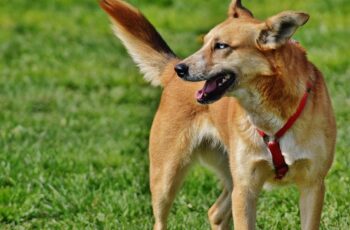Summertime. Most notably the hottest season of the year. With warmer weather also comes the rainy season in most areas, and with it – storms.
If your dog’s go-to reaction is to run and hide under the nearest piece of furniture or come running to be saved by you – the moment they hear the sound of thunder in the distance, this is one you won’t want to miss.
Clouds begin rolling in. There’s a change in the air, the sky begins to darken. There’s no denying it, a storm’s a-brewin’ and every year, many new dog parents encounter the question of “why are dogs scared of thunder?”
By the time we mere humans can hear or notice the first signs of thunder, we quickly realize that not only is the satellite TV signal out again, but our furry friend’s likely already at it. Seemingly trying to play hide and seek with the clouds rolling in.
Symptoms usually include shaking in their paws, pacing around, panting, tail tucked, and ears down. Some dogs may whimper or whine, while others simply let it be visually known that they’re not having any of it.
If your fur baby is anything like mine, you may also find yourself in the position of answering the request, or demand, to be picked up and/or comforted. Why does this happen you ask? Well, the answer might just surprise you. Read on to learn more.
While medication and supplements such as hemp-based CBD for dogs may exist, there are some other great non-medicinal solutions to consider, which can help bring comfort and calm to our beloved pet.
As the storm finally rolls in and rain begins tap, tap, tapping against the roof and windows, you may notice Fido is MIA – or missing in action. When feeling afraid, a go-to for our furry friends will usually be to hide under things, such as furniture that’s lower to the ground, and anything they can fit under.
Holistic pet therapist and author Sally Morgan shares that during a thunderstorm, dogs may lose their cool as an attempt at grounding themselves. They will usually do this by seeking the lowest areas they can find.
Noise plays a big part in this, but it’s only part of the reason.
Thunderstorms and other loud noises tend to be a trigger for dogs who suffer from noise phobia or noise anxiety. What is noise anxiety you ask? It tends to be an excessive fear of a noise, or sound, that results in your pal attempting to avoid, or escape from the sound when there’s no threat.
Other loud noises could include things such as fireworks or other common household sounds. For example, my furry little guy becomes alert and worried when I do things such as opening a large trash bag, to replace the full one in the bin. Unfortunately, noise anxiety is not specific to any age and can develop at any time throughout a dog’s life. Untreated, this condition can also worsen over time.
Understanding Why This Occurs
Some experts suspect this phobia might be the result of a dog’s natural survival instinct, requiring them to hear and be alert of anything occurring around them. Loud noises not only interfere with this nature-given ability, they also result in confusion and the fear of danger on its way.
It’s also worth noting that our reactions to what is happening at the time can also play a role, and have an impact on your pet’s behavior.
From surprisingly exclaiming how bright the crack of lightning was outside, to how loud that thunder was that just boomed outside your window, to even running around to check or shut windows, our furry friends tend to pick up on our energy and behavior which can lead them to falsely believe that something isn’t right, and a real need to be alert exists.
Being of a different species, a few other things worth considering are the fact that some dogs also tend to be more sensitive when it comes to changes in the atmosphere, such as pressure, humidity, etc.
Even the type of breed, and what your pooch was bred for. Regardless if their living in our homes does not reflect the original idea or purpose for that particular breed. For example, some dog breeds have been bred for hunting, shepherding, etc, and may have certain abilities that are stronger than in other breeds. Not to mention the fact that all dogs have an increased hearing ability in comparison to humans.
How to calm your dog’s anxiety during these times
1. Your Dog’s Behavior and You
While there are some things out of our control, such as our pet’s behavior of fear or panic, there are some things that we can do to help ease anxiety, stress, and fear. First would be going back to our own behavior, reactions, and anxieties, by remaining calm and showing your pooch that everything is okay.
This can be done in several ways, including speaking calmly to your pet and keeping a calm demeanor to help set a space, or example, of non-worry. Another option would be body compression, which can be achieved with an effective product known as the ThunderShirt.
2. Compression Therapy To The Rescue!
A ThunderShirt is similar to a jacket-like cover that applies gentle, constant pressure to calm anxiety, fear, and over-excitement due to a variety of environmental triggers. Easily held together with fasteners, it fits, and wears, similar to Spandex and some dogs do tend to find comfort from wearing it. Best of all, ThunderShirt has received raving reviews, achieving a 4 out of 5 start rating, across a large number of positive reviews and can be viewed here.
3. Caution On Encouraging Your Pooch
Showing love, and encouragement can help bring calm and good feelings to both you and your pet. However, be careful not to show too much positive re-enforcement to this behavior, as to not encourage it to continue.
While being kind, loving, and encouraging can feel nice – and may be second nature to give your fur baby pats, rubs, and show love to try and make them feel better, the idea here is to calm or comfort your dog by helping it understand that no danger is present – rather than encouraging them to continue the behavior like it’s something you want to see more of. In summary, excessive praise behavior or treats wouldn’t be a great idea during this time of fear behavior, as it could be counter-productive.
4. Don’t Let Static Stop You
Odd as it may seem, some dogs may also be sensitive to static electricity. This sensitivity may be triggered during thunderstorms and may be a contributing factor to their behavior in some cases. As a result, it may be helpful to bring Fido to a different room, with a non-conductive area or surface.
Non-conductive surfaces are generally ones that don’t allow static electricity to transfer. This will include things such as porcelain or plastic (think bathtubs), glass, rubber (mats), etc. Ultimately, if your dog is crate trained, it may also find comfort by being inside of its crate.
5. Change Things Up a Bit
From a visual standpoint, visual flashes of lightning can also add to stress and fear, in addition to loud crashes of thunder. As a result, closing window shades or blinds, and turning on a light to minimize flashes of light could prove helpful. Calming music can also be a helpful addition to create a separate space, minimizing the obvious sound of thunder, and bringing some focus away from the storm occurring just outside.
6. Sound Therapy
On the subject of music, playing tracks of thunderstorms from free sources like Youtube, or anything you can find, may also help with desensitizing your furry friend from the real thing when it comes around. It’s best to try this outside of the rainy season, so it’s in your control.
Experiment with lower volume levels at first, to start. When you find a level your dog remains calm at, as the audio track of the storm rages on, having a trigger command word is next. Saying a command word like saying “relax,” or anything you choose can help promote, and later achieve a feeling of calm, along with immediately giving a small treat for positive reinforcement.
A good idea would be to repeat this trigger word as you see your dog calm, and provide them with a treat to show them how good of a job they’re doing, during this fake storm. Repeat this as they remain calm, every 20 seconds or so. Gradually increasing the time between the word and treat combo, as you see them become more comfortable.
7. Supplements and Medication As a Last Resort
Ultimately, while the tips above can prove helpful in many cases, the best solution for some of our beloved canines may be anti-anxiety medication, which veterinarians would need to prescribe. Some alternatives would be natural herbal dog chews or hemp-based CBD products. One of our favorite sources for CBD products, for both humans and canines alike, can be found here.
With so many options, and alternatives available today, consulting with your veterinarian on treatment options may ultimately be best to determine what’s right for your pooch. Outside of edible solutions, pheromone products such as Adaptil, and essential oil or herbal dog collars can also prove effective for some canines.
Overall, please keep in mind that your Dog’s fear is very real. As such, it unfortunately isn’t something they choose to be afraid of or partake in. Noise phobia is ultimately a result of something that your pet is unable to understand, and we all have fears of our own, after all. Unfortunately, fear is something that’s ultimately out of our control. But it can be treated, and hopefully overcome, in time.



